Croke Park - In the name of love!
Richard Hayden of the STRI, and Robert Ellis, Senior Groundsman at Croke Park, provide us with an 'interesting' diary of events
June 2009: Turf replacement following Take That concert
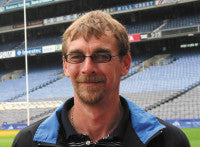 After the phenomenal success of the "Take That" concert in June the first twenty metres of the pitch at the Hill 16 end was replaced and returfed. "It was a tough decision to dig out the Desso, considering it had served so well for the previous three years. With annual fixtures of between seventy and eighty per year, including all codes of Gaelic football [run by the GAA -Gaelic Athletics Association], rugby, soccer and concerts, you do need a very stable surface.
After the phenomenal success of the "Take That" concert in June the first twenty metres of the pitch at the Hill 16 end was replaced and returfed. "It was a tough decision to dig out the Desso, considering it had served so well for the previous three years. With annual fixtures of between seventy and eighty per year, including all codes of Gaelic football [run by the GAA -Gaelic Athletics Association], rugby, soccer and concerts, you do need a very stable surface.
However, when you have stages down for over a week, on steel trackway, and matches just days afterwards, the only option is lay and play turf" said Richard Hayden of the STRI, who works closely with Rob Ellis, Senior Groundsman at Croke Park in Dublin.
"It's a project management and advisory partnership, we have with the STRI, rather than a traditional advisory role" says Rob, who served at Huddersfield's Galpharm stadium before moving to the jewel in the crown of the Emerald Isle. "As a team, we face enormous challenges; there is never a dull moment " says Rob, who is assisted by Paddy Walsh and Marcel Bantea.
"The big challenge was how to make a soil based sod on a fibresand pitch perform like a sand based Desso reinforced pitch. With just a week of bedding in, continuous tweaking of hardness and moisture within the turf achieved the end result. The new and the old matched perfectly and it was a huge confidence builder for what lay ahead just a month later."
Under the direction of stadium director, Peter McKenna, and a specially appointed GAA committee, plans were underway to replace the whole pitch after U2's up and coming '360' concert.
June - July 2009: Planning
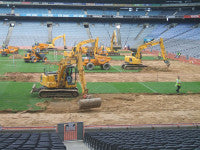 The decision to use turf from County Turf in Scunthorpe didn't come without controversy, with nationalist elements within Ireland claiming the use of British turf at Croke Park was, at the least, questionable.
The decision to use turf from County Turf in Scunthorpe didn't come without controversy, with nationalist elements within Ireland claiming the use of British turf at Croke Park was, at the least, questionable.
"We are not politicians; we are professional consultants" says Richard. "The turf product we wanted wasn't available in Ireland so we found it in the UK. Common sense prevailed after a few politicians had had their "rant" he says. "I stand by my decision."
Ireland held its breath and waited, in anticipation, for a car crash TV-like episode to unfold. It didn't happen.
Sunday July 12th 2009: Rootzone removal starts
As fifty staff from locally based sportsturf construction firm, Clive Richardson Limited, rolled on to the pitch, the spectacle of ten excavators, sixteen dumpers, eight tractors, two dozers and other equipment was a spectacle to behold.
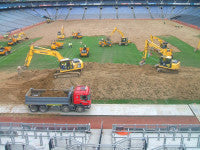 The excavations were done very carefully, removing just 200mm of rootzone and leaving the undersoil heating and irrigation intact. "We had to have every eventuality covered, which included an irrigation and undersoil heating repair team on site in case of an accident" said Richard. Operations were heavily restricted by the local council, in terms of vehicle movements and working hours, with work starting at 8.00am and finishing at 10.00pm. Within fours hours of the first evening, a quarter of the huge 15,500m2 pitch had been removed.
The excavations were done very carefully, removing just 200mm of rootzone and leaving the undersoil heating and irrigation intact. "We had to have every eventuality covered, which included an irrigation and undersoil heating repair team on site in case of an accident" said Richard. Operations were heavily restricted by the local council, in terms of vehicle movements and working hours, with work starting at 8.00am and finishing at 10.00pm. Within fours hours of the first evening, a quarter of the huge 15,500m2 pitch had been removed.
Monday July 13th 2009: Rootzone replacement starts
At this stage, twenty rigid trucks were on a continuous loop, removing the old rootzone and replacing with new. The logistical exercise of moving 6,000 tonnes of rootzone in and out of the stadium in two days was a challenge. Constant radio communication, as well as plenty of banksmen, allowed traffic to flow.
As the new rootzone stockpile built up in the carpark behind the stadium, a separate crew began hauling it onto the pitch and grading it. There were sixteen dumpers, ten excavators, two dozers, ten trucks, six tractors and nearly one hundred staff, all operating in spectacular choreography in such a tight space. As the new rootzone was taken in, and laser graded, engineers on the ground were taking close account of the depths and levels achieved. By Monday night the project was ahead of schedule by a full day. True to the nature of the venue, the dressing rooms were used as the nerve centre for the operation.
Tuesday July 14th 2009: Finishing and grading
B eing a day ahead of schedule allowed us to dedicate a full day to grading, trimming and raking the pitch prior to application of the fibre reinforcement. Attention focussed on hauling in the rest of the 3,000 plus tonnes of rootzone onto the pitch as well as handwork around the irrigation heads and goalpost sockets. The 3D laser box grader proved excellent in the final trimming and grading of the pitch. Getting the rootzone firmed up and consolidated was done by "wheeling in", using tractors driving back and forth.
eing a day ahead of schedule allowed us to dedicate a full day to grading, trimming and raking the pitch prior to application of the fibre reinforcement. Attention focussed on hauling in the rest of the 3,000 plus tonnes of rootzone onto the pitch as well as handwork around the irrigation heads and goalpost sockets. The 3D laser box grader proved excellent in the final trimming and grading of the pitch. Getting the rootzone firmed up and consolidated was done by "wheeling in", using tractors driving back and forth.
Wednesday July 15th: Fibre reinforcement
Carl Pass, of Premier Pitches, assisted in the application and amelioration of the fibre into the pitch. With the two application machines underway, the rain on the day helped keep down the dust, firm up the rootzone and allow a better amelioration. It is one of the few tasks in our business that benefits from torrential rain.
With the two applicators spreading the fibre, two tractors and power harrows tilled in the material to the specified depth. Handraking and working around services on the pitch was also important. Spreading and mixing in of the material was carried out in two passes each. With the fibre mixed to the correct concentration the pitch was wheel rolled again and raked with a specialist rake to get final grades on the pitch.
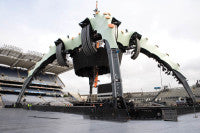 As the team retired on Wednesday evening they were two days ahead of schedule, with tolerances like a billiard table.
As the team retired on Wednesday evening they were two days ahead of schedule, with tolerances like a billiard table.
Thursday July 16th: Clean up
Just some finishing and tidying up was necessary before handover to the U2 concert team. Demobilisation of equipment, sweeping and cleaning of all the drains around the stadium was carried out. "Stage 2" of the project was complete and the crew left for a well earned rest.
Friday July 17th - Monday July 27th: Stage Preparations
To protect the pitch services from sinkage and settlement, a specially chosen geotextile membrane was placed over the fibre finished pitch before the plastic covering and steel flooring was placed. The U2 show was a phenomenal logistical exercise involving hundreds of trucks and personnel to build the 500 tonne 'claw' stage structure It took five days to build and stood out on the Dublin skyline for the eagerly anticipated shows.
S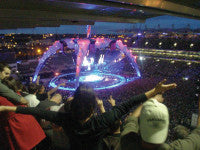 aturday July 26th: Turf Checking
aturday July 26th: Turf Checking
The final walk and assessment of the proposed turf was carried out on the evening of Saturday 26th of July. Turf assessment techniques have been developed at STRI for the likes of Croke Park and Wembley in recent times. If the turf doesn't pass the criteria, it isn't used.
Sunday 27th and Monday 28th July: Turf Transport
Transporting turf in 90 refrigerated wagons nearly 200 miles, and then across the Irish sea over a three day period, was a logistical challenge. Too cold and the turf will suffer from freezer burn on the edges, too warm and the centre will heat in the huge 1.2m x 10m rolls.
It is a really fine line between the two issues, and the damage from either extreme is a problem in a lay and play situation. There are so many functions affecting the rate of temperature drop of the turf. To credit Andy Fraser at County Turf, trials were undertaken, in the lead up to the project, to determine the perfect load, spacing and temperature to set the fridges.
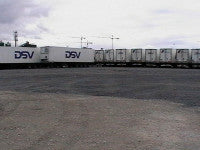 DSV Limited were the chosen hauliers for the project. As the last of three U2 concerts blasted out over Croke Park, ninety refrigerated wagons of turf filled a carpark on the road to Croke Park. A combination of representatives from County Turf and the STRI supervised the turf cooling and monitoring operation twenty-four hours a day, with reams of data being collected. The temperature of the wagons had to be continuously monitored and adjusted.
DSV Limited were the chosen hauliers for the project. As the last of three U2 concerts blasted out over Croke Park, ninety refrigerated wagons of turf filled a carpark on the road to Croke Park. A combination of representatives from County Turf and the STRI supervised the turf cooling and monitoring operation twenty-four hours a day, with reams of data being collected. The temperature of the wagons had to be continuously monitored and adjusted.
Tuesday July 29th: Protest
Before the U2 concert crew could start removing the stage, a local residents protest kicked off outside of the stadium at around 1.00 am. The protest was aimed at disrupting the twenty-four hour work licence granted by the local council to the concert promoters in removing the stage.
All works stopped as the team sat helplessly trying to control the temperature of 15,500m2 of turf. Finally, at 4.30pm, the residents called off the protest; and the project kicked off again, fourteen hours behind schedule.
Any time contingency was now gone and, with six games sold out for the venue the following Sunday and Monday, the pressure was on. Clive Richardson's men were supported by Talbot Farm Landscapes and Premier Pitches in the turf laying operation.
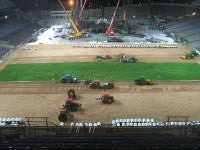
The first issue to deal with was the thawing of the turf, which takes between six to eight hours. If the thawing is left too long, the centres of the roll will heat within hours. At 10.30pm it was felt it would be beneficial to give the crew a four hour rest until 2.30 am. This also allowed the turf to thaw some more.
Wednesday July 30th: Laying continues
At 2.30am the crew of sixty returned to their positions and the job rolled on under floodlights. The U2 crew were still clearing the stage, so we had specific amounts of trucks and equipment in certain areas of the stadium which we 'owned' and they had theirs. At this stage there were around four hundred people working on the pitch - the U2 stage crew and the pitch crew.
Running the system worked well, with two laying machines manned by eight staff each. These were fed by eight tractors and spikes fed, in turn, by four forklifts.

The choreography of operations was important; an accident would close the entire project down. As the turf was laid it was snagged by the STRI and the seams washed and rolled. As the crew continued to lay the turf, the project captured the imagination of the country, if not the local residents!
Thursday July 31st: Laying complete
As the turf was placed it became apparent it had suffered considerable 'freezer burn' on the edges from the extra time it had spent in the refrigerated lorries during the protest. The last of the turf was laid at 8.15pm. Remarkably, the crew had clawed back most of the lost time. With the turf in place, and the pitch green, there was an all round sense of achievement.
Friday 1st and Saturday 2nd August: Pitch Preparations
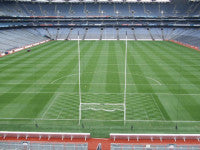 With the turf rolled, and the joints washed, the turf was mown and lines burnt in. At this stage the pressure was on the groundstaff to prepare the pitch. The STRI also had to carry out a series of performance tests on the pitch during this period. Remarkably, some of the best performance test results ever achieved at Croke Park were noted immediately after laying. Richard and Robert decided to mow narrow bays to mask any visible imperfections. With the turf only laid for twenty-four hours, some seams were visible, but it was agreed that the brief was safety, performance and aesthetics in that order.
With the turf rolled, and the joints washed, the turf was mown and lines burnt in. At this stage the pressure was on the groundstaff to prepare the pitch. The STRI also had to carry out a series of performance tests on the pitch during this period. Remarkably, some of the best performance test results ever achieved at Croke Park were noted immediately after laying. Richard and Robert decided to mow narrow bays to mask any visible imperfections. With the turf only laid for twenty-four hours, some seams were visible, but it was agreed that the brief was safety, performance and aesthetics in that order.
Sunday 3rd and Monday 4th August: Matchday
Croke Park staff and management were rewarded for their efforts after the first day of play. Following three hard games of Gaelic football, both players and managers complimented the pitch claiming it played perfect. Heartening headlines including "pitch perfect" and "Croker pitch plays a Blinder" were a further confidence boost.
 Six competitive games were played on the surface that weekend. Stage 3 of the project was complete. The GAA had pulled off a remarkable project.
Six competitive games were played on the surface that weekend. Stage 3 of the project was complete. The GAA had pulled off a remarkable project.
Further Work and Matches in September
In terms of aesthetics, the pitch got worse before it got better. All of the freezer burns had to be dyed, overseeded, sprayed and covered with germination blankets which had to be removed every two days for mowing over a four week period. The groundstaff did a remarkable job to bring the pitch back to 100% cover for the 2009 All Ireland Finals in September.
With the exception of one weekend in August the pitch played extremely well and, considering the weather and the usage that particular weekend, the focus remained on getting the pitch back to perfection. As both All Irelands came and went, the pitch played well and the presentation was exemplary.
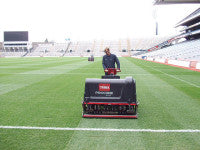 A very specific nutrient and cultural management programme included the use of a specific, cold process, dried seaweed extract, which achieved dense rooting of nearly 100mm in just four weeks!
A very specific nutrient and cultural management programme included the use of a specific, cold process, dried seaweed extract, which achieved dense rooting of nearly 100mm in just four weeks!
After enduring four pitch invasions of 50,000 people over the month of September, hollowcoring and topdressing aimed to winter proof the pitch.
Life gets easier?
At a time when it seemed the greatest challenge was overcome, the announcement that the stadium was to host an Irish international soccer match and rugby match within twelve hours of each other in November 2009 was met with optimism by the groundstaff. Robert agreed that it was a short period of time to have games in such proximity, considering posts, pitch markings, divoting and preparation for play, but he was confident it could be achieved.
The work started on the day before the match - with nearly two inches of rain falling. 
"The hollowcoring and topdressing pulled us through, and the pitch remained firm" says Richard, remembering that, just hours before, he and Robert had been standing on the pitch in a "once in every one hundred years" storm that had dumped over three inches of rain just hours before.
The pitch was double mown for the first match and looked fantastic for the football. Visitors agree that very few venues get the crisp line definition acheived on the croker stripes, mainly down to the height of the grass
Unfortunately, it was the beginning of the end of what was to be a controversial week for the Irish soccer team, with the 'Hand of Henry' sealing the team's fate.
A squad of twenty men divoted the pitch between the games. Magipaint was used for the line markings, which was removed by soft br ush by about 3.00am.
ush by about 3.00am.
With the posts changed and up, there was the usual cool and calm confidence as the logos were painted on the pitch at 8.00am. By 11.00am the crew had managed to remove the lines, divot the pitch, Honda mow, double cylinder mow and roll and re-mark the lines. The pitch played well for that match against Australia, and the match against South Africa just two weeks later, both of which Ireland won.
But the hidden winner was the pitch, and those responsible for delivering it.
